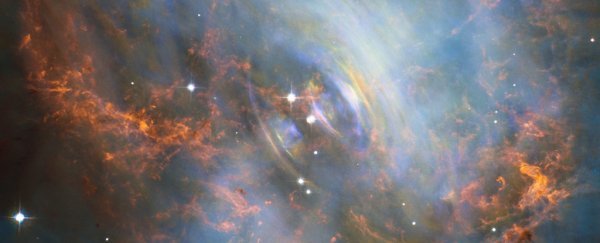Radio pulsars could be spitting way more powerful bursts of radiation into space than we knew.
According to a new survey of the Crab pulsar some 6,500 light-years away, a type of event known as “giant radio pulses” are accompanied by an increase in X-ray emission.
This means that these events are much more energetic than we thought; it also has implications for understanding the mysterious fast radio bursts (FRBs) that flare at Earth from millions of light-years away, across intergalactic space.
Radio pulsars are strange stellar beasties. They are a type of compact object known as a neutron star – the dense, collapsed core of a massive star that has gone supernova.
Many neutron stars are unremarkable, but pulsars … well, they pulse. They spin rapidly, beaming jets of radio emission from their poles; when those jets are oriented to flash past Earth, the stars pulse, like a rapid cosmic lighthouse, on timescales as short as milliseconds.
Not all pulsars behave the same, either. Some let out giant radio pulses – extremely short, millisecond-duration pulses of radio emission that are much stronger than the dead star’s normal emissions.
The Crab pulsar, at the heart of the picturesque Crab Nebula, is a star that went supernova a little under 1,000 years ago. It’s one of the youngest pulsars we know, with a spin period of 30 times a second.
It’s also a prolific giant pulser, and the only object we know of where these giant pulses are accompanied by an increase in emission outside of radio wavelengths. When the Crab pulsar booms, its optical light increases, too.
So an international team of astronomers led by Teruaki Enoto of the RIKEN Cluster for Pioneering Research in Japan went looking for other wavelengths. From around the world, they coordinated simultaneous observations of the pulsar using radio and X-ray telescopes, to see if they could detect an increase in X-ray emission in the giant radio pulses.
After three years, they finally detected a signal strong and clear enough to confirm that the Crab pulsar was indeed discharging around 4 percent extra X-ray emission with its giant radio pulses, suggesting that we have vastly underestimated the power of this phenomenon.
“Our measurements,” Enoto said, “imply that these giant pulses are hundreds of times more energetic than previously thought.”
We don’t actually know what causes giant radio pulses, so this is very interesting information to have. That 4 percent increase is in line with the increase in optical emission, which indicates that the higher energy radiation has the same spectral energy distribution as the normal pulses, the researchers said. This places some constraints on what can be causing the star to kick off.
What the team observed, they said, is consistent with magnetic reconnection – the release of energy that results when magnetic field lines around the star snap and reconnect. This is something the Sun does all the time; the result is a solar flare.
Giant radio pulses have also been suggested as a lower-energy version of the mysterious radio signals from other galaxies, known as fast radio bursts. Like giant radio pulses, fast radio bursts are (mostly) random, and last just milliseconds – but they come from much, much farther away and are therefore way more powerful.
Last year, astronomers detected for the first time an FRB coming from our own galaxy, emitted by a magnetar – that’s a type of neutron star with a really, really strong magnetic field. There is surprisingly little crossover between pulsars and magnetars, and some astronomers believe that magnetars could evolve from pulsars.
It’s possible that there is more than one mechanism producing FRBs, so the mystery is far from solved. This new research adds another clue. Some FRBs repeat; if they were being produced by a similar mechanism to giant radio pulses, the stars would dim too rapidly for the repeating behavior we’ve observed in at least one fast radio burst source.
So, we now know that there’s some other mechanism behind at least some fast radio bursts – but we can’t entirely rule out pulsar giant radio bursts for others.
“The relationship between the two is still controversial,” Enoto said. “These findings, along with upcoming discoveries regarding fast radio bursts, will help us to understand the relationship between these phenomena.”
We don’t know about you, but we just absolutely love a deepening space mystery.
The team’s research has been published in Science.



